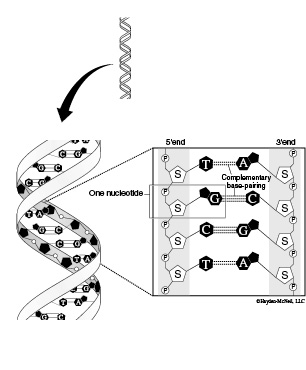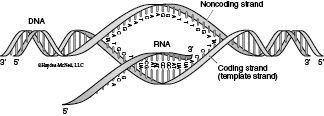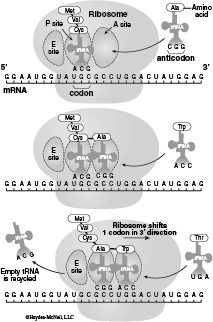Chapter 1. DNA Synthesis, Transcription and Translation
Overview

To understand DNA synthesis, transcription, and translation, where each occurs within the cell, and the function of each process.
It is important to understand how DNA is replicated and the ways in which genetic information can be used to make protein for many reasons. As an example, current theory states that in some forms of depression, the protein serotonin is not produced by the brain cells in sufficient amounts. Some preliminary data suggest that the basis of the problem may occur at the level of transcription, because the DNA does not take on the appropriate 3-dimensional shape to allow production of m-RNA at sufficient levels. It is with these realities in mind that we ask you to participate in this laboratory exercise.
DNA synthesis takes place during S phase of the cell cycle. The structure of DNA is complementary and antiparallel (Figure 1). The overall direction of DNA synthesis is in the 5’==> 3’ direction. DNA synthesis is semiconservative.
Many enzymes are necessary for DNA synthesis in eukaryotes. Among them are helicase, topoisomerase, primase, DNA polymerase, DNA ligase. Before you come to the lab you should learn the functions of these enzymes. Below is quick review of what you learned in lecture:

Transcription
During transcription, a single-stranded m-RNA is made from the DNA. An m-RNA is antiparallel and complementary to the DNA strand from which it is transcribed (Figure 2). The m-RNA moves from the nucleus of the cell through the nuclear pores to the cytoplasm where ribosome assembly takes place.

Translation

Ribosomes, t-RNA, and m-RNA are a few of the components necessary for translation (Figure 3). Translation is the actual physical assembly of the protein on the ribosome. The m-RNA codon is matched to the appropriate t-RNA anticodon. The t-RNA carries the anticodon at one end and the corresponding amino acid on the other. Amino acids are assembled into unique proteins based on the specific genetic instructions contained on various m-RNAs produced from the DNA.
Monohybrid Cross

DNA Sequencing
Please review this technique video on DNA sequencing.
DNA Sequencing.mp4 from Hayden-McNeil on Vimeo.